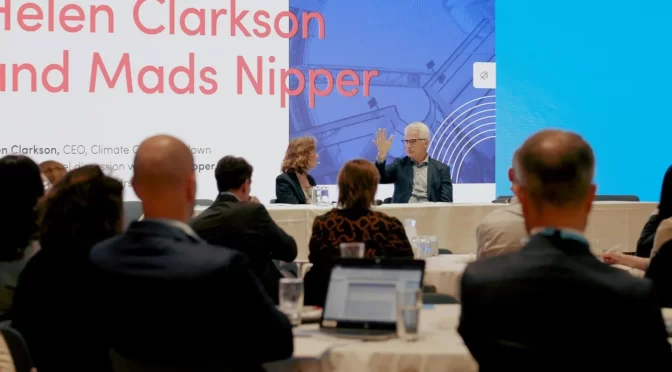Ørsted, a founding member of the SteelZero initiative, is teaming up with a global coalition of corporate first-movers to set out steps governments must take to support the steel industry in its drive to achieve net-zero emissions. With the new SteelZero policy principles paper, the coalition wants to help policymakers speed up the transition to decarbonised steel, which is critical to unlocking net-zero supply chains and meeting global climate goals.
On 31 May, Ørsted and Climate Group hosted the inaugural SteelZero summit, which explored policy solutions to decarbonise the steel sector, which represents 8 % of global CO2 emissions, and grow the net-zero carbon steel platform. Hosted at Ørsted’s headquarters in Copenhagen, Denmark, the summit was the first SteelZero event since the platform’s launch in 2020. With less than ten years to halve global emissions in line with the 1.5 °C pathway, decarbonising steelmaking is a critical part of the journey.
As a growing net-zero steel ‘buyers’ club’, the power of SteelZero lies in its cross-sectoral and global nature. Steel decabonisation is a challenge no single company can overcome on its own. But when working together, companies can build collaborative frameworks to drive the demand and push for the right market and investment frameworks that will enable businesses worldwide to speed up the transition to net-zero steel.
The SteelZero summit hosted over 100 participants, with speakers representing European, US, and Chinese companies. As part of ongoing efforts to grow the demand-side coalition, over 30 companies representing sectors including renewables, construction, and automotive that aren’t yet members of the coalition also joined the summit at a working level.
Mads Nipper, CEO of Ørsted, said: “I’m excited to see the launch of the SteelZero global policy principles paper. Governments now need to pull multiple levers to accelerate steel decarbonisation and must match policy action with growing demand-side ambition. This can help build access to a critical supply of green steel that allows companies to meet their climate goals in the coming decade. And it can help unlock future net-zero supply chains in the renewable energy sector. At Ørsted, we look forward to using our insights from the forefront of climate action to drive these collective efforts with SteelZero.”
Helen Clarkson, CEO of Climate Group, said: “We’re at a critical moment for the steel industry. Steel is a difficult material to decarbonise, and it’s going to take decades – not years – which means that for us to get on track for net-zero by 2050, the industry needs to get moving now. As shown by our SteelZero initiative, the business demand signal for net-zero steel is growing, but faster action is needed. That’s why bringing together businesses that buy and use steel, at this first-of-its-kind summit, is critical to unlocking progress at the speed that we need.”
Policy principles for net-zero steel
This summit is a significant milestone for SteelZero – and the wider sector transition. The coalition has already played a central role in shaping how industry and the international policy environment are defining low-emission, near-zero, and net-zero steel, and is now further raising the voice of the demand side on the essential policy issues that must be addressed by international, national, and sub-national governments, working in tandem with businesses to reach corporate climate commitments.
In particular, the new SteelZero policy principles paper calls on governments to align on how to define emerging terminology and include independently verified definitions in public sector procurement criteria, grow demand through public procurement to implement 2030 and 2050 targets, and promote consistent methodologies for measuring and reporting on embodied carbon, among other proposals.
Commitments and action
At the summit, members of the SteelZero platform agreed to continue to grow the demand-side action towards its 2030 and 2050 goals. As part of the SteelZero platform, members make public commitments to procure 50 % of their steel by 2030 from any combination of the following: a company with a validated science-based target, a site certified by ResponsibleSteel, or low-embodied carbon steel.
Members also commit to procuring 100 % net-zero steel by 2050. As a global renewable energy company that seeks to minimise its carbon footprint, including across its supply chain, Ørsted has committed to procuring 100 % net-zero steel ahead of schedule – by 2040 – in alignment with its science-based net-zero target for scope 1-3 emissions. To unlock net-zero supply chains that will enable the sustainable build-out of renewable energy in the future, Ørsted is working to both procure green steel and help power the green steel transition by producing green hydrogen needed in steel manufacturing.
How to join SteelZero
Joining SteelZero sends a powerful signal to steel producers, investors, and policymakers to accelerate the transition to wide-scale production of net-zero steel. SteelZero provides a platform for leading organisations, their peers, and suppliers to come together and address some of the barriers they currently face in their steel supply chains. For more information, click here.


